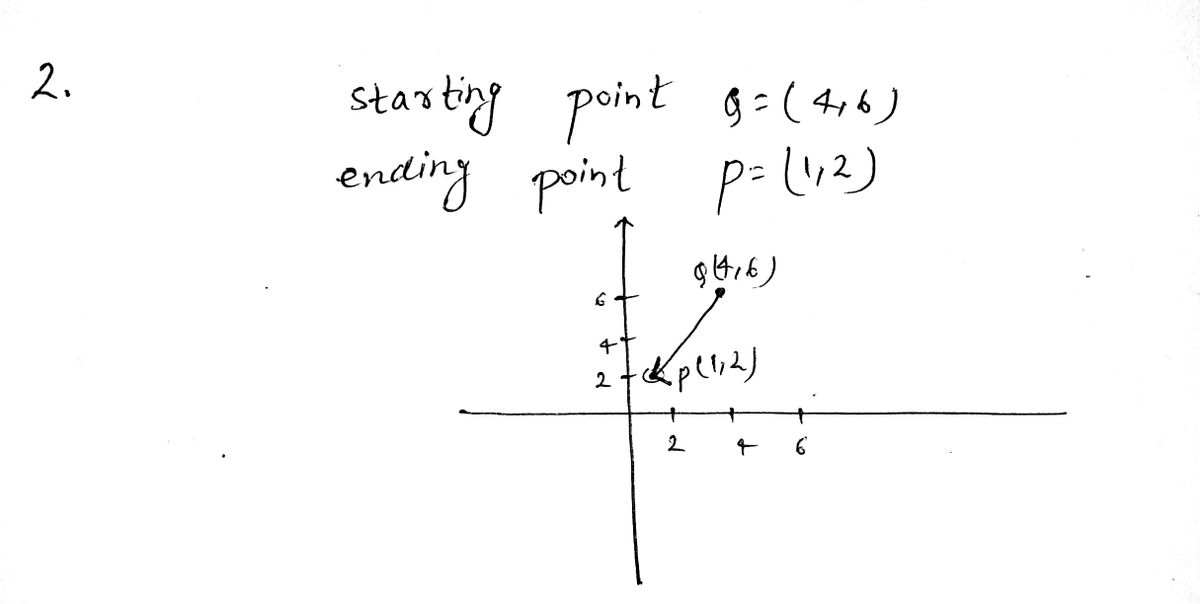Calculus: Early Transcendentals
8th Edition
ISBN:9781285741550
Author:James Stewart
Publisher:James Stewart
Chapter1: Functions And Models
Section: Chapter Questions
Problem 1RCC: (a) What is a function? What are its domain and range? (b) What is the graph of a function? (c) How...
Related questions
Question

Transcribed Image Text:In Exercises 1–6, resolve the vectors into components.
1.
This diagram shows a coordinate plane with three vectors \( \vec{a} \), \( \vec{b} \), and \( \vec{w} \).
- Vector \( \vec{a} \) originates from the origin and points into the first quadrant, with its tail at the origin and head in the direction of positive \( x \) and \( y \) on the plane.
- Vector \( \vec{b} \) also originates from the origin and extends into the first quadrant, lying closer to the \( x \)-axis, indicating a larger \( x \)-component relative to its \( y \)-component.
- Vector \( \vec{w} \) starts from the origin and is directed into the second quadrant, indicating a negative \( x \)-component and a positive \( y \)-component.
- Vector \( \vec{v} \) is in the third quadrant, with both components negative.
The axes are labeled with \( x \) and \( y \), ranging from -3 to 3. The goal is to resolve each vector into its \( x \) and \( y \) components.
![**3. A vector starting at the point \( Q = (4, 6) \) and ending at the point \( P = (1, 2) \).**
This description refers to a vector in a two-dimensional coordinate system. The vector begins at the coordinates \( Q \) and terminates at \( P \). The direction and length of the vector are determined by these coordinates.
To calculate the vector from \( Q \) to \( P \), subtract the coordinates of \( Q \) from \( P \):
\[
PQ = (1 - 4, 2 - 6) = (-3, -4)
\]
The vector \( PQ = (-3, -4) \) points from \( Q \) to \( P \).](/v2/_next/image?url=https%3A%2F%2Fcontent.bartleby.com%2Fqna-images%2Fquestion%2Fd839df97-12d3-4f31-81a6-72bdcfb45177%2F09e12958-28b8-45bb-a638-da1254253ef6%2F2ho8uj_processed.png&w=3840&q=75)
Transcribed Image Text:**3. A vector starting at the point \( Q = (4, 6) \) and ending at the point \( P = (1, 2) \).**
This description refers to a vector in a two-dimensional coordinate system. The vector begins at the coordinates \( Q \) and terminates at \( P \). The direction and length of the vector are determined by these coordinates.
To calculate the vector from \( Q \) to \( P \), subtract the coordinates of \( Q \) from \( P \):
\[
PQ = (1 - 4, 2 - 6) = (-3, -4)
\]
The vector \( PQ = (-3, -4) \) points from \( Q \) to \( P \).
Expert Solution
Step 1

Step by step
Solved in 3 steps with 2 images

Recommended textbooks for you

Calculus: Early Transcendentals
Calculus
ISBN:
9781285741550
Author:
James Stewart
Publisher:
Cengage Learning

Thomas' Calculus (14th Edition)
Calculus
ISBN:
9780134438986
Author:
Joel R. Hass, Christopher E. Heil, Maurice D. Weir
Publisher:
PEARSON

Calculus: Early Transcendentals (3rd Edition)
Calculus
ISBN:
9780134763644
Author:
William L. Briggs, Lyle Cochran, Bernard Gillett, Eric Schulz
Publisher:
PEARSON

Calculus: Early Transcendentals
Calculus
ISBN:
9781285741550
Author:
James Stewart
Publisher:
Cengage Learning

Thomas' Calculus (14th Edition)
Calculus
ISBN:
9780134438986
Author:
Joel R. Hass, Christopher E. Heil, Maurice D. Weir
Publisher:
PEARSON

Calculus: Early Transcendentals (3rd Edition)
Calculus
ISBN:
9780134763644
Author:
William L. Briggs, Lyle Cochran, Bernard Gillett, Eric Schulz
Publisher:
PEARSON

Calculus: Early Transcendentals
Calculus
ISBN:
9781319050740
Author:
Jon Rogawski, Colin Adams, Robert Franzosa
Publisher:
W. H. Freeman


Calculus: Early Transcendental Functions
Calculus
ISBN:
9781337552516
Author:
Ron Larson, Bruce H. Edwards
Publisher:
Cengage Learning